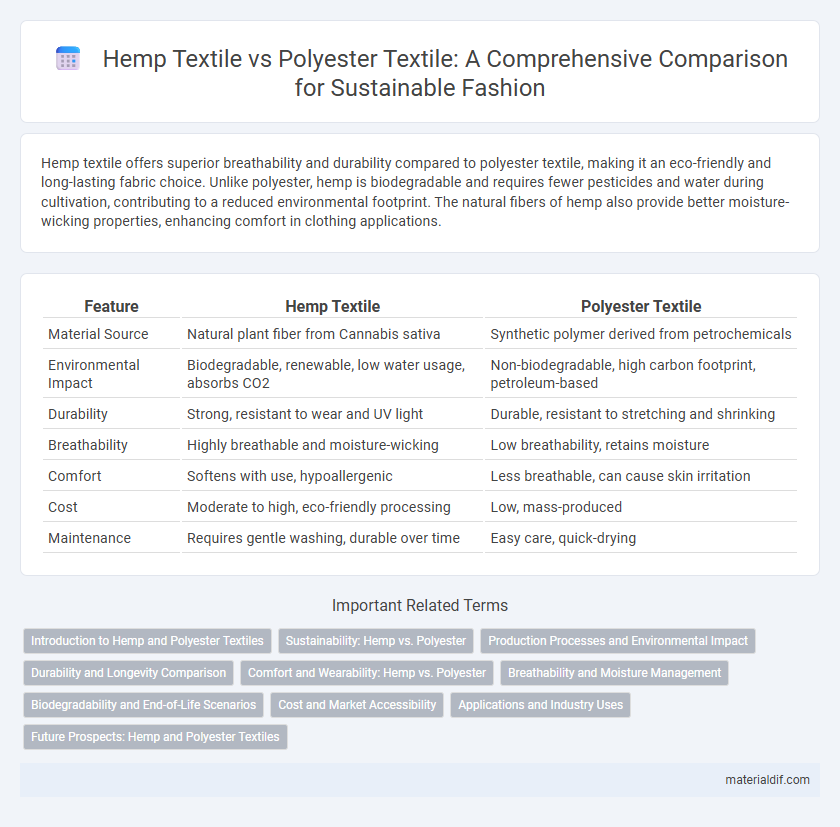Hemp textile offers superior breathability and durability compared to polyester textile, making it an eco-friendly and long-lasting fabric choice. Unlike polyester, hemp is biodegradable and requires fewer pesticides and water during cultivation, contributing to a reduced environmental footprint. The natural fibers of hemp also provide better moisture-wicking properties, enhancing comfort in clothing applications.
Table of Comparison
| Feature | Hemp Textile | Polyester Textile |
|---|---|---|
| Material Source | Natural plant fiber from Cannabis sativa | Synthetic polymer derived from petrochemicals |
| Environmental Impact | Biodegradable, renewable, low water usage, absorbs CO2 | Non-biodegradable, high carbon footprint, petroleum-based |
| Durability | Strong, resistant to wear and UV light | Durable, resistant to stretching and shrinking |
| Breathability | Highly breathable and moisture-wicking | Low breathability, retains moisture |
| Comfort | Softens with use, hypoallergenic | Less breathable, can cause skin irritation |
| Cost | Moderate to high, eco-friendly processing | Low, mass-produced |
| Maintenance | Requires gentle washing, durable over time | Easy care, quick-drying |
Introduction to Hemp and Polyester Textiles
Hemp textiles are produced from the fibers of the Cannabis sativa plant, known for their durability, breathability, and natural resistance to mold and UV rays, making them an eco-friendly and sustainable alternative to synthetic fabrics. Polyester textiles, derived from petrochemical sources, offer high tensile strength, moisture-wicking properties, and wrinkle resistance but contribute to microplastic pollution and have a larger environmental footprint. The rising demand for sustainable fashion has increased interest in hemp textiles due to their biodegradability and minimal water usage compared to polyester production.
Sustainability: Hemp vs. Polyester
Hemp textiles are significantly more sustainable than polyester due to their natural biodegradability and lower environmental impact during production. Hemp cultivation requires minimal water, no pesticides, and absorbs large amounts of CO2, whereas polyester manufacturing relies on fossil fuels and releases microplastics during washing. Choosing hemp over polyester reduces carbon footprint and supports eco-friendly, renewable textile industries.
Production Processes and Environmental Impact
Hemp textile production involves natural fiber extraction through retting and decortication, requiring less water and energy compared to polyester's petroleum-based synthesis and chemical-intensive processing. Hemp cultivation improves soil health and sequesters carbon, offering a biodegradable and renewable alternative, whereas polyester manufacturing emits significant greenhouse gases and contributes to microplastic pollution. The biodegradability of hemp fibers reduces landfill waste, contrasting with polyester's persistence and environmental burden throughout its lifecycle.
Durability and Longevity Comparison
Hemp textiles demonstrate significantly higher durability and longevity compared to polyester fabrics due to their strong natural fibers that resist wear and tear over time. Unlike polyester, which tends to degrade and pill with repeated washing and UV exposure, hemp fabric becomes softer and maintains its strength, offering sustained performance. The natural resistance of hemp to mold, mildew, and UV damage further enhances its lifespan, making it a more sustainable choice for long-term textile use.
Comfort and Wearability: Hemp vs. Polyester
Hemp textiles offer superior breathability and moisture-wicking properties compared to polyester, making them more comfortable for extended wear. The natural fibers of hemp also provide excellent durability and become softer with each wash, enhancing wearability over time. In contrast, polyester tends to trap heat and moisture, which can lead to discomfort and reduced breathability during prolonged use.
Breathability and Moisture Management
Hemp textile offers superior breathability compared to polyester, allowing better air circulation and reducing heat retention in clothing. Its natural fibers wick moisture away from the skin effectively, promoting faster drying and enhanced comfort. In contrast, polyester tends to trap heat and moisture, leading to diminished breathability and less efficient moisture management.
Biodegradability and End-of-Life Scenarios
Hemp textile offers superior biodegradability compared to polyester, breaking down naturally within months without leaving harmful microplastics in the environment. In end-of-life scenarios, hemp decomposes into nutrient-rich organic matter that supports soil health, whereas polyester persists for hundreds of years in landfills or contributes to ocean pollution. Choosing hemp reduces ecological footprints and promotes sustainable waste management in the textile industry.
Cost and Market Accessibility
Hemp textile production generally incurs higher initial costs due to limited large-scale cultivation and processing infrastructure, while polyester benefits from mass production and lower raw material expenses derived from petroleum. Market accessibility for hemp textiles is expanding amid growing consumer demand for sustainable fabrics and improved processing technologies, yet polyester remains dominant in global markets due to established supply chains and lower price points. Cost efficiency and widespread availability continue to position polyester as a more accessible option, though hemp's eco-friendly advantages drive niche market growth and increasing commercial investments.
Applications and Industry Uses
Hemp textile outperforms polyester in applications requiring sustainability, biodegradability, and moisture-wicking properties, making it ideal for eco-friendly fashion, home textiles, and industrial fabrics. Polyester textile dominates in high-performance sportswear, outdoor gear, and upholstery due to its durability, wrinkle resistance, and cost-effectiveness. Industries such as automotive, fashion, and interiors increasingly adopt hemp textiles for their environmental benefits, while polyester remains prevalent in mass-produced, synthetic fabric markets.
Future Prospects: Hemp and Polyester Textiles
Hemp textiles offer superior sustainability with biodegradable fibers and a lower environmental footprint compared to polyester, which relies on petroleum-based production and contributes to microplastic pollution. Innovations in hemp fiber processing are enhancing fabric softness and durability, positioning hemp as a viable alternative in fashion and industrial applications. As consumer demand shifts toward eco-friendly materials, hemp textiles are expected to capture a growing market share, challenging polyester's dominance in the textile industry.
hemp textile vs polyester textile Infographic

 materialdif.com
materialdif.com